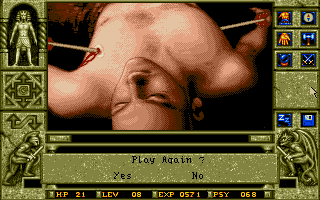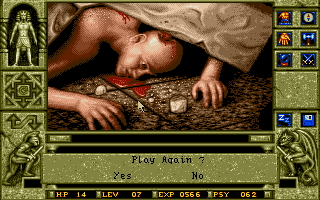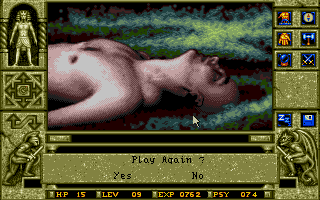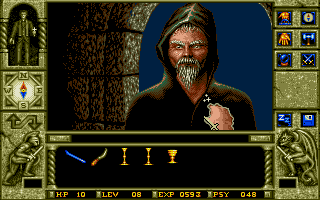From The CRPG Addict
 |
| Sometimes the game is more fun for its gruesome death images than from actually defeating the challenges. |
I’ve solved two of the four or more Waxworks scenarios, and started to explore a third, and it’s a measure of the game that I have no idea what to expect from the last. Waxworks seems to delight in changing the rules between scenarios, which is good for variety’s sake, although I haven’t found any of the scenarios so far terribly challenging or compelling.
The first one had me explore a six-level pyramid, with each level getting smaller as it went up (just as in the recent Beneath the Pyramids). There were branches here and there, but in general the pyramid’s levels were linear enough that I didn’t have to map. I died about a thousand times, with 950 of those deaths due to tripwire traps, which you have to click on and “avoid” every time you cross. No matter how many times I told myself to watch out for them, no matter how many times I thought I remembered the positions of specific ones, I just kept setting them off.
The rolling-rock traps are unavoidable but also easy to dodge. You just have to dart down a nearby hallway when you see the rock coming. If you back up, you can easily outrun it.
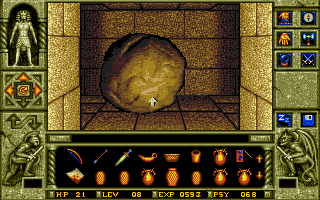 |
| The rock rolls harmlessly by as I hide in a side passage. |
The levels had a fair share of spear-wielding guards and dagger-wielding priests, and my survival against them was mostly luck. Among the six levels, you’re limited to the hit points you start with, those you develop by leveling, and another 40 or so that you can restore by having Uncle Boris create the scrolls for you. Combat, meanwhile, is just a matter of activating it and clicking around the screen. For the pyramid, I wasn’t able to detect that a particular area of the screen resulted in a greater chance of hitting, or more damage, nor was I able to determine whether choosing a variety of attacks had more success than just spamming the same attack over and over. There was a clear escalation in weapons–dagger, sword, spear–and the enemies definitely went down faster as my level increased.
It turned out not to matter that I loaded up my inventory with everything not nailed down. You have no encumbrance statistic and no maximum number of items, and carrying a bunch of redundant pots actually helped at one point. You just have to take care not to accidentally stick new items in jars or baskets, because you then have to spend half an hour looking into every one that you have to find it.
That leaves the puzzles. One recurring puzzle required me to find a series of tuning forks and then use them to shatter glass walls. The tuning forks all had different frequencies, and I thought there might be some complex puzzle associated with that, but the game never made use of the frequencies as such. Different tuning forks shattered different walls and that was it.
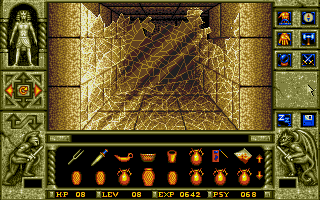 |
| Captured this screenshot just at the right time. |
I also had to watch out for blocks propped up by wooden beams and collapse those beams with a hammer, thus causing blocks to fall from upper levels and clear the passages. There were a couple of points at which it was possible to put myself on the wrong side of the passage before collapsing it, and thus end up in a “walking dead” situation. In fact, there are enough walking dead situations in the game to require a careful approach to saving, and in particular keeping a save from the last time you were in the Waxworks in case you have to start over completely.
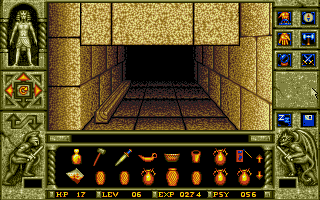 |
| Collapsing the passage. |
Level 1’s major puzzle involved a pool of water where I needed to fill up some jugs, so I could pour the water on some hot coals on Level 2. Messing with the water got me attacked and killed by a crocodile, so I had to find a way to lure the crocodile out of the water while I held my spear ready. The only thing that made sense for bait was a pile of entrails I’d found in one of the jars. By dropping that on the tile before the water, I was able to entice the croc out of the pool and then kill him with a thrown spear.
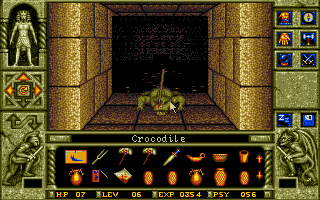 |
| See ya later. |
We already saw the door puzzle between Levels 1 and 2. The major obstacle here, other than the many traps and guards, was that square of burning coals. The game did me a favor by filling up all my jugs with water on Level 1, so I had enough (it turned out I needed 5) to cool the coals instead of making me fill, say, three, and then realize I didn’t have enough, and have to trudge back and forth multiple times.
The transition between Level 2 and Level 3 had a door puzzle in which I had to twist a series of valves to divert a flow of water into a preferred jug (with an ankh symbol on it), filling it faster than the jugs with snakes on them. It really couldn’t have been easier. I just had to trace the pipes backwards and turn the valves accordingly.
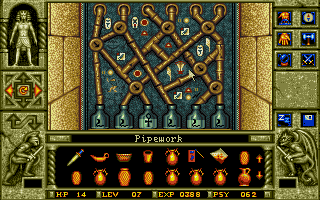 |
| An easy puzzle. |
Level 3’s big challenge–again, after traps and enemies–was to weigh down a pot and thus open a door. There was no more obvious object to weigh down the pot than two piles of sand I’d previously found in some corridor. Thus must have been an introductory level.
Level 4 had a couple of obstacles. One required me to knock down a bridge by shooting it with a bow and arrow, but again the choice was fairly obvious. Later, I had to cross an area of tiles by stepping on the right hieroglyphic tiles. This one took me a few minutes to suss out. A message said to “follow the path of life.”
The only other hieroglyphics I’d seen were on a piece of papyrus from the first chamber. Each row of tiles, from which I had to choose one to step on, had two tiles that were on the piece of paper and one tile that was not. I figured the trick was to step on the one that was not, and that did get me safely across the room. Only later, when I thought about it, did I realize the game’s logic. The specific arrangement of the hieroglyphics on the papyrus didn’t matter; what mattered is that they were all associated with Anubis, the god of death, and thus the “path of life” would take me across symbols
not associated with him. That’s reasonably clever.
 |
| Crossing the perilous floor. |
On Level 5, I was almost immediately stymied by a puzzle in which gas started filling the corridors and the exits were closed off. I found a “mirror” on one wall, but it threw me for a while because it seemed to show a picture of a guard. I realized well after I should have that the “picture” was actually my image in the mirror. I’m not
me in these exhibits; rather, I have taken possession of the “good” brother, who in this case is a pyramid guard named Cassim. This was all explained later when I made more liberal use of Boris’s head. I had been conserving my “psy,” but I realized later that I was just wasting it.
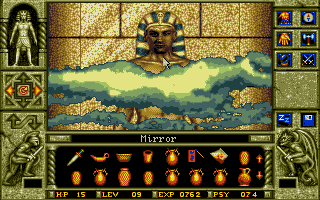 |
| This is supposed to be me? |
Solving the gas puzzle involved shattering the mirror, which of course was done with a collection of the tuning forks, something that should have been more obvious.
Later on Level 5, I reached a couple of rooms with murals on the walls–very nice murals, I should add. Graphically,
Waxworks can be lovely. The two consecutive murals on the south walls all produced hollow sounds when tapped, so I realized I could smash through them with my weapon to reveal chambers beyond. The first one had a piece of tile that, when I picked it up, released snakes into the room. I couldn’t fight the snakes and they killed me. The solution was to spill oil all over the floor and ignite it before picking up the piece, so that the snakes emerged into an inferno.
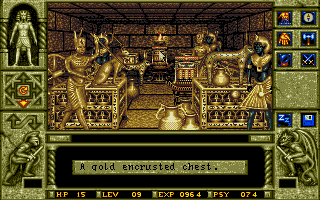 |
| A treasure room holds only a couple relevant items. |
The transition between Levels 5 and 6 required me to arrange four tiles (which I’d picked up at various places along the way, the first three without any fuss) in a particular order. I never found anything that helped me determine the order, but there were only 24 possibilities, and I got it after about 6.
On Level 6, I rescued my princess by opening her sarcophagus with a scarab beetle found all the way back in the first room. She oddly ended up in my inventory, which was also what happened to Elvira in
Elvira II.
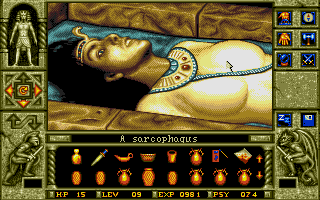 |
| I don’t mean to complain, but her face looks rather masculine. |
To finish off the level, I had to balance a scale using a series of weights I’d picked up in various places throughout the pyramid. It took me a while to realize that the weights are not all the same weight; by examining them, you see that they are “very light,” “light,” “heavy, “very heavy,” and “extremely heavy.” The puzzle still took a while longer because it didn’t occur to me that you might be able to solve it without using all the weights. I believe the solution had the extremely heavy and light weights on one side, the heavy and very heavy ones on the other, and no use of the very light weight.
 |
| Trying to figure out a balancing puzzle while “my betrothed” sits in my inventory. |
Solving the weight puzzle opened a door where I confronted and killed my evil twin brother, then exited the world somehow by putting a brooch into a hole on a statue’s belly.
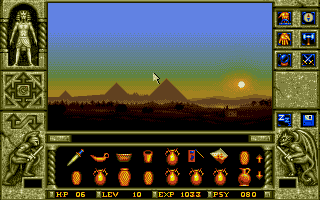 |
| A nice final shot of Egypt before we leave. |
I was not prepared for my accumulated experience and levels to drain away the moment I left ancient Egypt. But that’s what happens: in between each of the scenarios (at least, I assume the pattern continues), everything resets to 0. You inventory also disappears, too, which is more of a blessing. I guess it really doesn’t matter, then, which order you experience the exhibits because there’s no way to save the harder ones for when you’re stronger. I guess I get the logic, but it’s another blow to
Waxworks as an RPG.
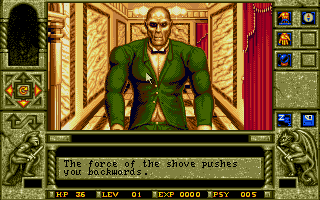 |
| Hey! Don’t you work for me now?! |
When I returned to the waxworks, Uncle Boris’s butler became weirdly hostile, pushing me down the corridors and trying to shove me into any exhibit I happened to come across. I had to run ahead of him to enter the exhibit of my choosing, which was the undead graveyard.
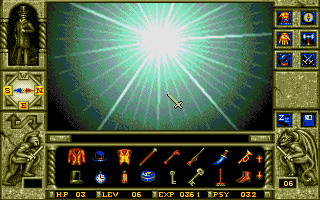 |
| Transitioning between areas. |
This was a very different experience, and I wasn’t prepared for how different it was. Instead of multiple levels, it occupied only one “level” about the same size as the first level of the pyramid. It had only a couple of puzzles and was, overall, a lot shorter than the first challenge.
What it
did have is zombies. Dozens of them. They pop out of the ground right in front of you, and I don’t think you can ever kill them all. You only have (or I only found) one weapon to fight them: a sickle. To kill a zombie, you first have to chop off one arm, then the other, then its head, so the locations that you click do make a major difference in these combats.
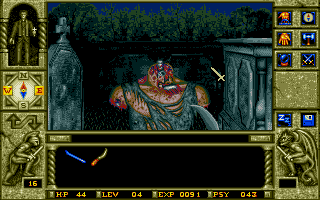 |
| I’m not sure why I couldn’t have gone right for the head. |
A lesser challenge, but perhaps more annoying, was simply mapping the area. Gravestones serve as “walls” within the cemetery, but it’s very hard to visually judge how close you can walk to them and exactly where you can turn and move forward. While you’re dithering around trying to find paths, zombies are appearing around every corner.
 |
| Is it clear to you that you can move one step forward here? Because you can. |
If you find the heart from a dead woman in the middle of the cemetery, Boris can use it to heal you once during the adventure. Since your hit points are thus finite, you want to avoid combat as much as possible, which is hard when you’re trying to comprehensively explore the map. Eventually, I just resigned myself to dying a lot of times while I mapped, and to then complete the level after a final reload.
There were three major puzzles in the area. The first required me to get access to the family crypt, for which I needed some tool to exploit a hole. Uncle Boris’s head suggested I search the fence around the graveyard for a loose bit of railing. I’m glad I consulted him because I absolutely never would have found that on my own. It’s hard to find even if you know what you’re looking for.
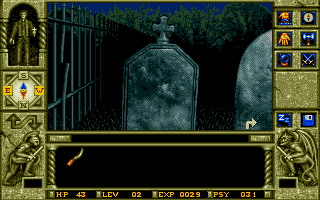 |
| You have to be facing a particular direction. Even then, it wouldn’t have occurred to me that you can pick up that broken piece of iron. It looks like it’s still attached. |
Once inside the crypt, I was able to speak to my ancestor Druec, who somehow knew I was from the future and not the original inhabitant of the body before him. He confirmed Uncle Boris’s accounts of the curse and said that in the current time, Vladimir had bound the souls of his forebears, not allowing them to die, using their energy to fuel his necromantic rituals.
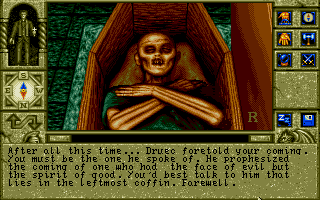 |
| Conversing with the first generation of cursed. |
Boris said he could break Vladimir’s aspell, but he would need an “absorbent material.” This turned out to be a hunk of bread, found in an altar in a chapel in the far northwest corner of the map. A vampire guarded it, but I’d found a stake on the way, sharpened it with the sickle, and pounded it into the vampire’s chest the moment he appeared.
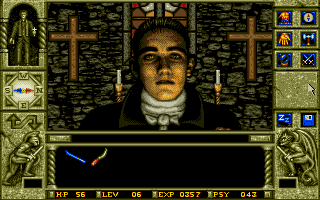 |
| As I put the stake to his heard, the vampire appears to be regretting life. |
Vladimir himself was just up a stairway from the chapel, but he was impervious to physical attack and killed me. Boris, meanwhile, had to fashion his counter-spell within the family crypt, so I had to trudge back through most of the map, killing zombies along the way. In the crypt, Boris completed them spell and told me to activate it, I should simply touch Vladimir. I turned around and walked back through the graveyard again, fighting more zombies.
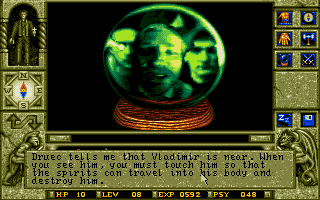 |
| This game is about to offer an interesting take on “destroy.” |
In my best run, I still made it back to the chapel with only a few hit points to spare. Boris said I should “touch” Vladimir, so I equipped my hands as weapons and poked him in the chest. For reasons I don’t fully understand, touching him caused him to collapse into a baby. Moments later, I was back in the waxworks, the butler approaching me menacingly down the hallway. As before, my experience points and level were reset to 0.
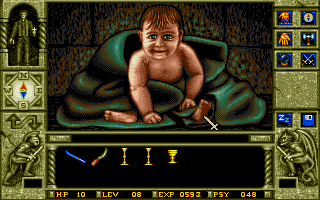 |
| If anyone has an explanation for this, I’d appreciate hearing it. |
I immediately leapt into the Jack the Ripper waxwork and found myself on the streets of Victorian London, over the body of Jack’s latest victim. This one is clearly going to offer a new challenge–avoiding patrolling bobbies and mobs of Londoners on the streets. Every time one manages to enter my square (or I blunder into theirs), it’s an immediate death. I still prefer it to the tripwires in the pyramid.
 |
| The Met has come a long way since then. |
By now, it’s clear that Waxworks mostly fails as an RPG, and what we have here is not a hybrid but an adventure game with “RPG elements.” A few years ago, I wouldn’t have known the difference. Now I realize that a good hybrid manages to preserve what people enjoy about both genres. On the RPG side, it offers a fully-realized combat, equipment, and character development system. It doesn’t just toss in hit points and experience points.
That means that to the extent that I’m enjoying Waxworks, it’s mostly for its adventure elements. So far, most of the puzzles have been relatively fair, particularly with the optional Boris-head hint system, and I’ve had some moments of satisfaction figuring them out. The graphics are well-done and immersive, though on the sound side the developers put too much effort into the music (which is era-appropriate, atmospheric, and, for me, as usual, turned off) and not enough into sound effects, which mostly only occur during combat.
Unless the game pulls the rug out from under me with additional unlocked scenarios, it looks like I’m already half done with this one. I’ll try to finish it up in one more.
Time so far: 10 hours
Original URL: http://crpgaddict.blogspot.com/2019/06/waxworks-hammer-and-sickle.html


